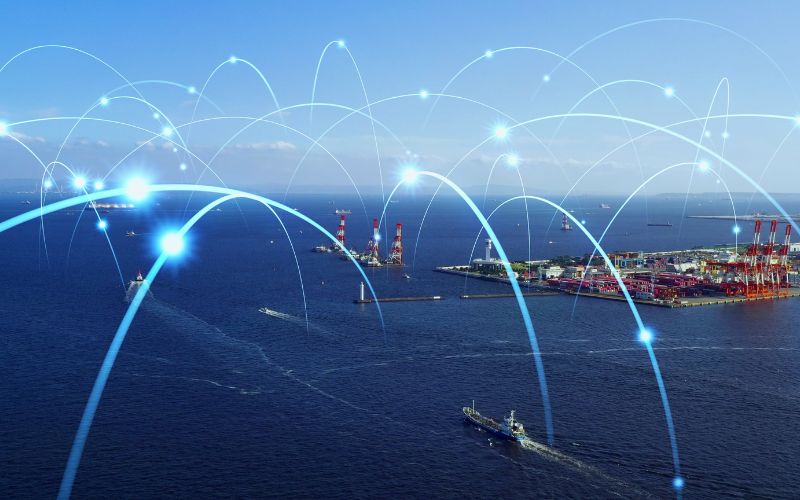What Are Sea Lines of Communication?
Why Sea Lines of Communication (SLOCs) Are Crucial for Global Trade and Security

What Are Sea Lines of Communication (SLOCs)?
Sea Lines of Communication, or SLOCs, are the major sea routes that connect ports worldwide. These routes are like highways for ships, helping countries trade goods, transport military supplies, and support logistics operations. They are critical for global trade during peacetime and play an even bigger role in times of conflict. Whoever controls SLOCs during war gains a powerful advantage, as history has shown in many naval battles.
Why Are Sea Lines of Communication Important?
SLOCs act as the lifeline for countries by keeping goods flowing across oceans. They promote economic growth, sustain trade, and support global supply chains.
In 2021, over 11 billion tonnes of goods were transported by sea—a 3.2% rise from 2020. Compared to the early 1990s, when maritime trade stood at 4 billion tonnes, today’s volume has doubled. The world’s shipping fleet has also expanded by 40%, reaching 2.1 million deadweight tonnes in 2021.
Without secure sea routes, trade can’t thrive, and economies could suffer. That’s why protecting these vital routes is essential for the smooth movement of goods.
How Are SLOCs Protected?
The strategy used to protect sea routes and chokepoints is known as sea control. Maritime chokepoints—narrow sea passages between oceans—are often congested and vulnerable to threats like pirate attacks. Some well-known chokepoints include:
- Malacca Strait
- Hormuz Strait
- Suez Canal
Ensuring sea control helps prevent enemies from using these routes for warfare and keeps global trade safe. It also ensures countries maintain their rights to navigate these waters without interference.
The Role of Geography in SLOCs
Geography plays a key role in how SLOCs are used and protected. Military planners study geography to position their naval forces based on the locations of allies, enemies, and key waterways. Economists also focus on using the shortest and safest routes to minimize costs and ensure timely delivery of goods.
For example, India holds a strategic position between the Malacca Strait and Hormuz Strait, two of the world’s most important sea routes. Ships passing through these areas carry vital cargo, including oil from the Persian Gulf, making India responsible for maintaining order in these waters.
Major Threats to Sea Lines of Communication
Several dangers threaten the safety and smooth operation of SLOCs:
1. Pirate Attacks
The Malacca and Singapore Straits, among the busiest sea routes, are piracy hotspots. In 2022, 58 piracy incidents were reported in Southeast Asia. In early 2023 alone, 41 attacks were recorded—an increase compared to the same period in 2022. Pirates often take advantage of shallow waters and complex geography to attack slow-moving vessels, leaving crews traumatized.
2. Drug Trafficking
Southwest and Southeast Asia are known for producing heroin and opium. Countries like Myanmar ship drugs through unregulated sea routes, despite strict laws. Smugglers use hidden routes in the Indian Ocean to move drugs toward Europe and other destinations.
3. Illegal Fishing
Overfishing is another threat. Fish is a primary protein source for billions of people, and half of the world’s catch comes from Asian waters. However, illegal fishing—often by fishermen from Thailand and China—causes problems by depleting fish stocks and threatening the livelihood of local communities.
4. Marine Pollution
Busy sea lanes like the Malacca Strait are prone to accidents, including oil spills and ship collisions. Such incidents can lead to environmental disasters, harming marine life and coastal communities. Marine debris like abandoned fishing nets and shipwrecks also add to pollution.
5. Smuggling of People
Every year, millions of people leave their home countries in search of better jobs or safety. Unfortunately, smugglers often transport migrants on overcrowded and unsafe boats. Many migrants perish at sea while trying to cross dangerous waters.
6. Sea Mines
Naval forces use sea mines to block or threaten enemy ships. In the past, mines have been placed in critical waterways, such as the Red Sea and Persian Gulf, making these areas dangerous for both trade and naval operations.
7. Human Error and Equipment Failures
Despite technological advancements, accidents still happen at sea due to human mistakes or poorly maintained ships. Collisions, groundings, and mechanical breakdowns can disrupt trade and cause serious problems for rescue operations.
How Can SLOCs Be Safeguarded?
To keep SLOCs safe, countries must work together and take the following steps:
- Anti-piracy patrols: Conduct joint naval missions to reduce piracy threats.
- Environmental protection: Monitor sensitive regions for pollution and accidents.
- Technology use: Employ satellites, drones, and artificial intelligence to monitor sea routes.
- Military exercises: Conduct naval drills to prepare for emergencies.
- Search and rescue missions: Collaborate on rescue efforts in case of accidents or smuggling incidents.
- Surveillance: Use ships and uncrewed vessels to patrol high-risk areas.
Conclusion
Sea Lines of Communication (SLOCs) are the backbone of the global economy. Ships loaded with goods—ranging from food to fuel—use these routes to reach their destinations. However, threats like piracy, pollution, illegal fishing, and drug trafficking make it crucial to protect these routes.
With countries working together to safeguard SLOCs, the world can ensure that maritime trade continues smoothly, keeping economies strong and connected.
